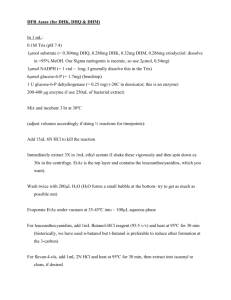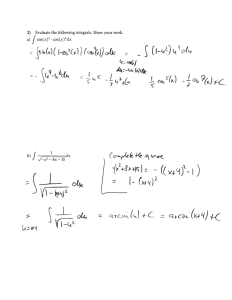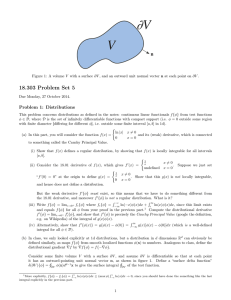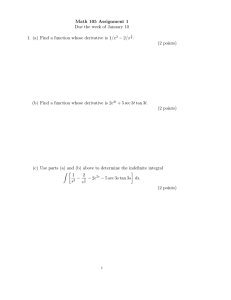Existence Theorem for Abstract Measure Differential Equations Involving the Distributional Henstock-Kurzweil Integral
advertisement
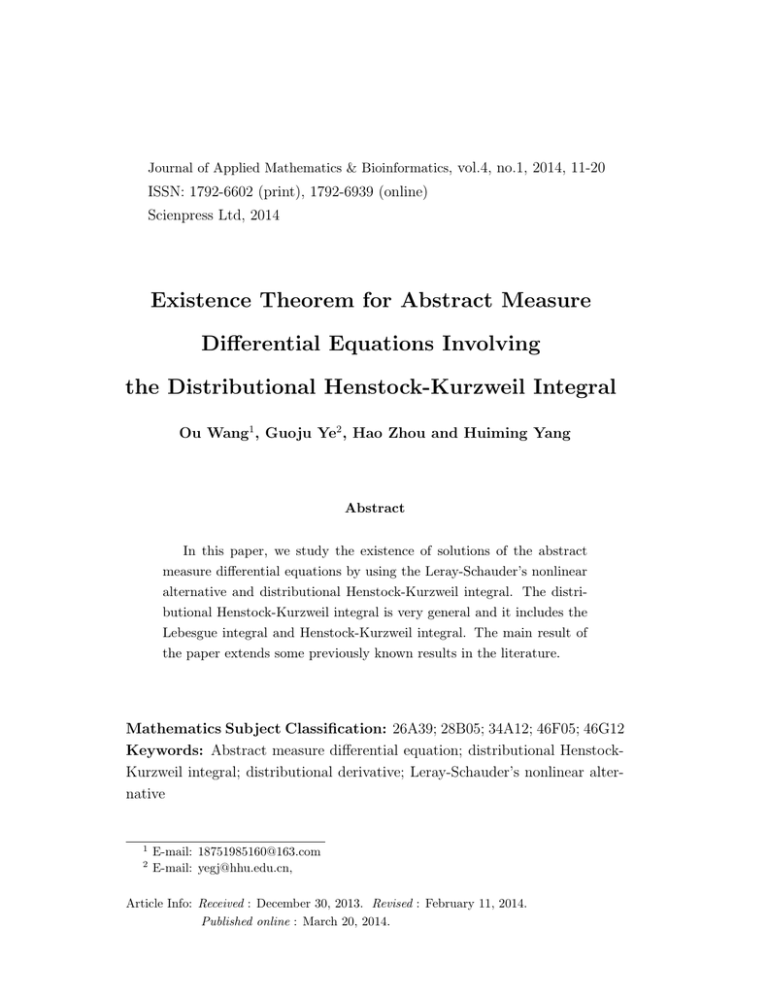
Journal of Applied Mathematics & Bioinformatics, vol.4, no.1, 2014, 11-20
ISSN: 1792-6602 (print), 1792-6939 (online)
Scienpress Ltd, 2014
Existence Theorem for Abstract Measure
Differential Equations Involving
the Distributional Henstock-Kurzweil Integral
Ou Wang1 , Guoju Ye2 , Hao Zhou and Huiming Yang
Abstract
In this paper, we study the existence of solutions of the abstract
measure differential equations by using the Leray-Schauder’s nonlinear
alternative and distributional Henstock-Kurzweil integral. The distributional Henstock-Kurzweil integral is very general and it includes the
Lebesgue integral and Henstock-Kurzweil integral. The main result of
the paper extends some previously known results in the literature.
Mathematics Subject Classification: 26A39; 28B05; 34A12; 46F05; 46G12
Keywords: Abstract measure differential equation; distributional HenstockKurzweil integral; distributional derivative; Leray-Schauder’s nonlinear alternative
1
2
E-mail: 18751985160@163.com
E-mail: yegj@hhu.edu.cn,
Article Info: Received : December 30, 2013. Revised : February 11, 2014.
Published online : March 20, 2014.
12
1
Distributional Henstock-Kurzweil Integral
Introduction
In this paper, we consider the abstract measure differential equation (AMDE)
dλ
= f (x, λ(S̄x )),
dµ
(1.1)
where (X, M, µ) is a measure space, S̄x is a certain measureable set for each
dλ
stands for the distributional derivative of λ ∈ Ca(X, M), f is
x ∈ X, and dµ
a distribution (generalized function).
It is well known that distributional derivative includes ordinary derivative
and approximate derivative. Hence, (1.1) has a universality.
The general AMDE of the form
dλ
= f (x, λ(S̄x ))
(1.2)
dµ
dλ
with Radon-Nikodym derivative dµ
and f : Sx × (−a, a) (a is a positive real
number) has been studied extensively in [1,2,4,5,6]. R.R. Sharma in [1] proved
the existence and uniqueness of solution of the equation (1.2) by the principle of contraction mapping. In [6], the authors considered the existence and
uniqueness of solution of the equation (1.2) applying the Leray-Schauder alternative [7] under Caratháodory conditions. However, as far as we know, few
papers have applied distributional derivatives to study the AMDE. In this paper, by using distributional derivatives, we study the existence of solutions of
AMDE (1.1).
We organize this paper as follows. In section 2, we introduce a general
integral called distributional Henstock-Kurzweil integral or DHK -integral. In
section 3, we will give the statement of the problem and the Leray-Schauder’s
nonlinear alternative that needed later. In section 4, we apply the LeraySchauder’s nonlinear alternative to prove the existence of solutions of the
AMDE (1.1).
2
The Distributional Henstock-Kurzweil Integral
In this section, we present the definition and some basic properties of the
distributional Henstock-Kurzweil integral.
13
Ou Wang, Guoju Ye, Hao Zhou and Huiming Yang
Define the space
Cc∞ = {φ : R → R | φ ∈ C ∞ and φ has compact support in R},
where the support of a function φ is the closure of the set on which φ does
not vanish, denoted by supp(φ). A sequence {φn } ⊂ Cc∞ converges to φ ∈ Cc∞
if there is a compact set K such that all φn have supports in K and the
(m)
sequence of derivatives φn converges to φ(m) uniformly on K for every m ∈ N.
Denote Cc∞ endowed with this convergence property by D. Also, φ is called
test f unction if φ ∈ D. The dual space to D is denoted by D0 and its elements
are called distributions. That is, if f ∈ D0 then f : D → R, and we write
hf, φi ∈ R, for φ ∈ D.
For all f ∈ D0 , we define the distributional derivative Df of f to be a
distribution satisfying hDf, φi = −hf, φ0 i, where φ is a test function and φ0
is the ordinary derivative of φ. With this definition, all distributions have
derivatives of all orders and each derivative is a distribution.
Let (a, b) be an open interval in R. We define
D((a, b)) = {φ : (a, b) → R | φ ∈ Cc∞ and φ has compact support in (a, b)}.
The dual space of D((a, b)) is denoted by D0 ((a, b)).
Define BC = {F ∈ C([a, b]) | F (a) = 0} is a Banach space with the uniform
norm
kF k∞ = max |F |.
[a,b]
Now we are able to introduce the definition of the DHK -integral.
A distribution f is distributionally Henstock-Kurzweil integrable or briefly
DHK -integrable on [a, b] if f is the distributional derivative of a continuous
function F ∈ BC .
Rb
The DHK -integral of f on [a, b] is denoted by (DHK ) a f = F (b), where F
R
is called the primitive of f and “(DHK ) ” denotes the DHK -integral. Notice
that if f ∈ DHK then f has many primitives in C([a, b]), but f has exactly
one primitive in BC .
The space of DHK -integrable distributions is defined by
DHK = {f ∈ D0 ((a, b)) | f = DF for some F ∈ BC }.
With this definition, if f ∈ DHK then, for all φ ∈ D((a, b)),
Z b
0
hf, φi = hDF, φi = −hF, φ i = −
F φ0 .
a
14
Distributional Henstock-Kurzweil Integral
Remark 2.2. Integrals defined in the same way have also been proposed in
other papers. For example, Ang [3] defined an integral in the plane and called
it the G-integral, and Talvila [10] defined the AC -integral on the extended
real line. In fact, these two integrals are equivalent to the DHK -integral for
one-dimensional intervals.
The following result is known as the fundamental theorem of calculus.
Lemma 2.3. [10,Theorem 4].
Rt
(a) Let f ∈ DHK , and define F (t) = (DHK ) a f . Then F ∈ BC and
DF = f .
Rt
(b) Let F ∈ C([a, b]). Then (DHK ) a DF = F (t) − F (a) for all t ∈ [a, b].
Example 2.4. We know that the primitive function F of the HK-integral
function f is ACG∗ (generalized absolutely continuous; see [11,12]). In [12,
Example 6.6], Lee pointed out that if F is a continuous function and pointwise
differentiable nearly everywhere on [a,b], then F is ACG∗ . Furthermore, if
F is a continuous function which is differentiable nowhere on [a,b], then F is
not ACG∗ . Therefore, if F ∈ C([a, b]) but is differentiable nowhere on [a,b],
then DF exists and is DHK -integrable but not HK-integrable. Conversely, if
F is ACG∗ then it also belongs to C([a, b]). Therefore, F 0 is not only HKintegrable but also DHK -integrable. Here F 0 denotes the ordinary derivative
of F .
This example shows that the DHK -integral includes the HK-integral, and
hence the Lebesgue and Riemann integrals.
Some other results about the distributional derivative and the DHK -integral
are given below.
For f ∈ DHK and F ∈ BC with DF = f , we define the Alexiewicz norm
by
kf k = kF k∞ = max |F |.
[a,b]
The following result has been proved.
Lemma 2.5. [10, Theorem 2] With the Alexiewicz norm, DHK is a Banach
space.
It is known that there is a pointwise ordering in C([a, b]) (so it is with
BC ), that is, u ≤ v in C([a, b]) if and only if u(t) ≤ v(t) for every t ∈ [a, b].
Ou Wang, Guoju Ye, Hao Zhou and Huiming Yang
15
We now impose a partial ordering on DHK : for f, g ∈ DHK , we say that
f º g(or g ¹ f ) if and only if f − g is a positive measure on [a,b]. By this
definition, if f, g ∈ DHK then
Z
Z
b
(DHK )
b
f ≥ (DHK )
a
g, where f º g.
(2.2)
a
According to the definition of this ordering, we also have the result.
Lemma 2.6. [3, Corollary 1]. If f1 , f2 , f3 ∈ D0 ((a, b)), f1 ¹ f2 ¹ f3 , and if
f1 and f3 are DHK -integrable, then f2 is also DHK -integrable.
We say that a sequence {fn } ⊂ DHK converges strongly to f ∈ DHK if
kfn − f k → 0 as n → ∞. The following two convergence theorems hold.
Lemma 2.7. [3, Corollary4, Monotone convergence theorem for the DHK integral]. Let {fn }∞
n=0 be a sequence in DHK such that f0 ¹ f1 ¹ · · · ¹
Rb
fn ¹ · · · , and that (DHK ) a fn → A as n → ∞. Then fn → f in DHK and
Rb
(DHK ) a f = A.
Lemma 2.8. [1, Corollary 5, Dominated convergence theorem for the
0
DHK -integral]. Let {fn }∞
n=0 be a sequence in DHK such that fn → f in D .
Suppose that there exist f− , f+ ∈ DHK satisfying f− ¹ fn ¹ f+ for all n ∈ N.
Rb
Rb
Then f ∈ DHK and limn→∞ (DHK ) a fn = (DHK ) a f .
3
Statement of the problem
Let X be a linear space on R. For each x ∈ X, defined
Sx = {αx : −∞ < α < 1},
S̄x = {αx : −∞ < α ≤ 1}.
Let M be a σ-algebra in X, containing the sets S̄x for all x ∈ X, and let
µ be a positive σ-finite measure on M.
For a measure space (X, M), Ca(X, M) denotes the space of all countably
additive scalar functions on M. Define a norm k · k on Ca(X, M) by
kλk = |λ|(X),
(3.1)
16
Distributional Henstock-Kurzweil Integral
where |λ| is a total variation measure of λ and is given by
|λ|(X) = sup
∞
X
|λ(Ei )|, Ei ⊂ X,
(3.2)
i=1
where the supremum is taken over all possible partitions {Ei : i ∈ N} of X.
It is known that Ca(X, M) is a Banach space with respect to the norm k · k
defined by (3.1).
Let X0 ⊂ X and x0 ∈ X0 be fixed, and let M0 be the smallest σ-algebra
in X0 containing S̄x0 − Sx0 and the sets S̄x for x ∈ X0 − Sx0 .
Given a λ ∈ Ca(X0 , M0 ) with λ ¿ µ, consider the abstract measure
differential equation (AMDE) in (1.1)
dλ
= f (x, λ(S̄x )),
dµ
dλ
where dµ
is a distributional derivative of λ, f : Sx × (−a, a) → R, and f is
DHK -integral for each λ ∈ Ca(X0 , M0 ).
Definition 3.1. Let α0 ∈ (−a, a), a measure λ ∈ Ca(X0 , M0 ) will be
called a solution of AMDE (1.1) on X0 with initial data [S̄x0 , α0 ] if
(1)λ(S̄x0 ) = α0 ,
(2)λ(E) ∈ (−a, a), E ∈ M0 ,
R
(3)λ(E) = (DHK ) E f (x, S̄x )dµ0 for E ⊂ X0 − Sx0 , where µ0 is the restriction of µ on M0 .
In the following section we shall prove the main existence theorem for
AMDE (1.1) under suitable condition on f . We will use the following form of
the Leray-Schauder’s nonlinear alternative. See Dugundji and Granas [7] for
details.
Theorem 3.1. Let B(0, r) and B[0, r] denote respectively the open and
closed balls in a Banach space X centered at the origin 0 of radius r, for some
r > 0. Let T : B[0, r] → X be a completely continuous operator. Then either
(1) the operator equation T x = x has a solution in B[0, r], or
(2) there exists an u ∈ X with kuk = r such that u = pT u for some
0 < p < 1.
17
Ou Wang, Guoju Ye, Hao Zhou and Huiming Yang
4
Existence Theorem
In this section, we shall study the AMDE in (1.1)
dλ
= f (x, λ(S̄x )),
dµ
dλ
denotes the distributional derivative of λ ∈ Ca(X, M), and f is
where dµ
a distribution. Through this section, we denote by DHK the space of DHK R0
integrable functions and by 0 (∗) the *-integral.
We now impose some assumptions on the distribution f .
(D1 ) f (·, λ(·)) is DHK -integrable for every fixed λ ∈ Ca(X, M),
(D2 ) f (x, ·) is continuous for all x ∈ Sx ,
(D3 ) there exist f− , f+ ∈ DHK , for all x ∈ Sx , we have
f− ¹ f (x, ·) ¹ f+ .
We are now ready to give our main result.
Theorem 4.1. Let α0 ∈ (−a, a), x0 ∈ X0 . If the distribution f in AMDE
(1.1) satisfies assumptions (D1 ) − (D3 ), then there exist a solution of (1.1) on
X0 with initial date [S̄x0 , α0 ].
R
R
Proof Let M = supE {|(DHK ) E f− | , |(DHK ) E f+ |}, E ⊂ X0 − Sx0 (E ∈
M0 ), then
Z
Z
|(DHK )
f− | ≤ M,
|(DHK )
E
f+ | ≤ M.
(4.2)
E
By (2.2), (4.2) and condition (D3 ), we get
Z
|(DHK ) f | ≤ M.
E
Consider the space Ca(X0 , M0 ) where M0 is the smallest σ-algebra containing S̄x0 − Sx0 and all the sets of the form S̄x for x ∈ X0 − Sx0 . Let
k = |α0 | + M and r > k, r is a real number. Let B[0, r] be a closed ball in
Ca(X0 , M0 ), and for all λ ∈ B[0, r], we have the properties
λ(S̄x0 ) = α0 ,
and
kλk ≤ k.
18
Distributional Henstock-Kurzweil Integral
Moreover for each λ ∈ B[0, r], we have
|λ(E)| ≤ |λ|(E) ≤ kλk ≤ k,
E ∈ M0 .
Let T be the mapping defined on B[0, r] by
(
α,
R 0
(T λ)(E) =
(DHK ) E f (x, λ(S̄x ))dµ,
(4.3)
f or E = S̄x0 ,
f or E ⊂ X0 − Sx0 .
Then T λ ∈ Ca(X0 , M0 ) and
kT λk = |α0 | + (DHK )
R
X0 −Sx0
|f (x, λ(S̄x ))|d|µ|
≤ |α0 | + M
= k.
Therefore, T λ ∈ B[0, r], then T (B[0, r]) ⊂ B[0, r], thus T (B[0, r]) is uniformly
bounded in Ca(X0 , M0 ).
Let λ1 , λ2 ∈ B[0, r], by (4.3), we have
(
0,
f or E = S̄x0 ,
R
(T λ1 − T λ2 )(E) =
(DHK ) E [f (x, λ1 (S̄x )) − f (x, λ2 (S̄x ))]dµ,
f or E ⊂ X0 − Sx0 .
By condition (D2 ), we know, for each ε > 0, there exist δ(ε) > 0, when
|λ1 (S̄x ) − λ2 (S̄x )| < δ, we have
|f (x, λ1 ) − f (x, λ2 )| < ε.
Then
kT λ1 − T λ2 k = (DHK )
R
E
|f (x, λ1 (S̄x )) − f (x, λ2 (S̄x ))|d|µ| ≤ |µ|(X0 − Sx0 ) · ε.
This shows that T (B[0, r]) is equiuniformly continuous in Ca(X0 , M0 ). In
view of the Ascoli-Arzelà theorem, T (B[0, r]) is a relatively compact subset of
Ca(X0 , M0 ).
We now need to prove that T is continuous. Let {λn } be a sequence in
B[0, r], and λn → λ. Then according condition (D2 ),
f (·, λn ) → f (·, λ), as n → ∞
Thus, by Lemma 2.8. and
Z
Z
lim (DHK ) f (x, λm (S̄x ))µ = (DHK ) f (x, λ(S̄x ))dµ.
m→∞
E
E
Ou Wang, Guoju Ye, Hao Zhou and Huiming Yang
19
Therefore, limm→∞ T λm = T λ, which implies that T is continuous. Thus
T is a compact mapping. Hence an application of Theorem 3.1 yields that
either x = T x has a solution or the operator equation x = pT x has a solution
u with kuk = r for some 0 < p < 1. We shall show that this later assertion is
not possible. We assume the contrary. Then we have
(
pα0 ,
f or E = S̄x0 ,
R
u(E) = pT u(E) =
p(DHK ) E f (x, u(S̄x ))dµ,
f or E ⊂ Srx0 − Sx0 .
Hence
R
|u(E)| = |pα0 | + |p(DHK ) E |f (x, u(S̄x ))dµ|
R
≤ |α0 | + |(DHK ) E |f (x, u(S̄x ))dµ|
≤ |α0 | + M
= k.
This futher implies that
kuk = |u|(E) ≤ k.
Substituting kuk = r in the above inequality, this yields r ≤ k, which is a
contradiction to the inequality r > k.
Hence the operator equation λ = T λ has a solution. Consequently the
AMDE (1.1) has a solution λ0 , λ0 is then the solution of AMDE (1.1) on X0
with initial date [S̄x0 , α0 ]. This completes the proof.
Remark 4.2. In AMDE (1.1), if f satisfies the conditions in Theorem 1
in [1] that there exists a µ-integrable function w such that |f (x, α)| ≤ w(x)
uniformly in α ∈ (−a, a), and f satisfies a Lipschitz condition in α, then f
satisfies Theorem 4.1, thus Theorem 4.1 is an extension of Theorem 1 in [1].
References
[1] R.R. Sharma, An abstract measure differential equation, Proc. Amer.
Math. Soc., 32, (1972), 503-510.
[2] R.R. Sharma, Existence of solutions of abstract measure differential equations, Proc. Amer. Math. Soc., 32, (1972), 129-136.
20
Distributional Henstock-Kurzweil Integral
[3] D.D. Ang, K. Schmitt and L.K. Vy, A multidimensional analogue of the
Denjoy-Perron-Henstock-Kurzweil integral, Bull. Belg. Math. Soc. Simon
Stevin, 4, (1997), 355-371.
[4] G.R. Shendge, S.R. Joshi, Abstract measure differential inequlities and
applications, Acta Math. Hung., 41, (1983), 53-59.
[5] B.C. Dhage, On abstract measure integra-differential equations, J. Math.
Phys. Sci., 20, (1986), 367-380.
[6] B.C. Dhage, D. N. Chate, S. K. Ntouyas, Abstract measure differential
equation, Dynamic Systems Appl., 13, (2004), 105-117.
[7] J. Dugundji and A. Granas, Fixed point theory, Monograhie Math. PNW,
Warsaw, 1982.
[8] B.C. Dhage and S.S. Bellale, Existence theorems for perturbed abstract
measure differential equations, Nonlinear Analysis, 71, (2009), e319-e328.
[9] W. Liu, G.J. Ye, Y. Wang and X.Y. Zhou, On periodic solutions for
first-order differential equations involving the distributional HenstockKurzweil integral, Bull. Aust. Math. Soc., 86, (2012), 327-338.
[10] E. Talvila, The distributional Denjoy integral, Real Anal. Exchange, 33,
(2008), 51-82.
[11] Š. Schwabik and G.J. Ye, Topics in Banach Space Integration, World
Scientific, Singapore, 2005.
[12] P.Y. Lee, Lanzhou Lecture on Henstock Integration, World Scientific, Singapore, 1989.
